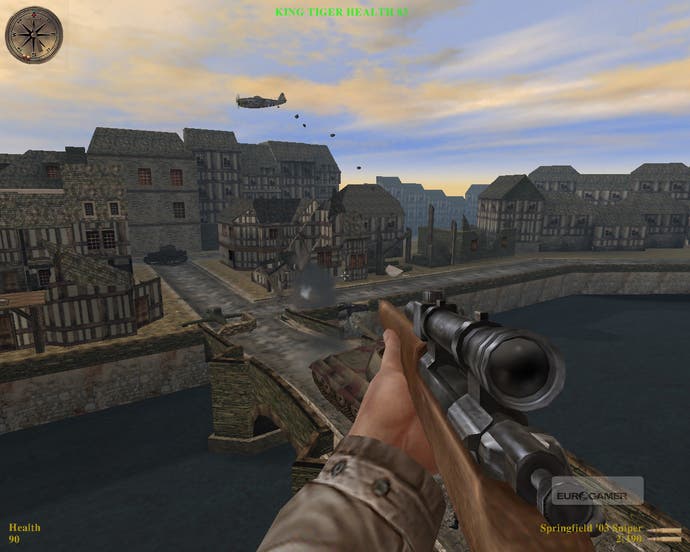Retrospective: Medal of Honor: Allied Assault
How the Modern Warfare was won.
Enemies, meanwhile, despite extremely selective hearing, appeared to genuinely fear your attacks - peeking out from behind corners and legging it away from your thrown grenades. Taking down a tank with a Panzerfaust from the windows of a steadily destroyed building, or frantically making your way up to a half-wrecked church across a graveyard with three machinegun emplacements pointing in your direction, were unquestionably epic moments - and still feel quite special today.
That mission in the French town with all the snipers though? That's more of a pain in the arse than it ever was. Elsewhere, however, the concentration on long-distance snipe-centric gameplay is still rather special. To my memory, Allied Assault is the first game that forced you to stare suspiciously at distant foliage to try to make out whether there was a Nazi helmet somewhere behind it. Ignoring a Nazi behind a bush, of course, will always end in trouble (just ask Western Europe). Allied Assault was not only made back in the days where healthpacks ruled the roost (good thing), but also where shooters were a lot more content to punish with little to no warning.
Something else that's grown hazy in the memory (and was slightly lost when the COD brand descended) is the emphasis on stealth gameplay. It was Call of Duty that really hammered home the feeling of 'en masse' warfare, yet in comparison much of Allied Assault comprises 'behind enemy lines' play that would sit well in a Commandos game. It's these levels, the ones that show off themes of sneaking and subterfuge, that shine through on a repeat play. The most notable section, for example, is the superb non-combat sequence that has you walk through a submarine base brandishing stolen identity papers, stealing extra ones as you go along. It makes you feel much like Indiana Jones in his ill-fitting stolen Nazi uniform at the close of Raiders.

Another rather freeform set-piece that remains fresh to this day has a Project IGI tang [Oh my god! Remember that! - Ed], which the Call of Duty games would also veer away from, having you take out the patrolling Nazis in the gardens of a mansion house and keeping anyone from slamming an alarm, before storming the various wings of the house itself to forage for documents and radio transmitters.
In terms of tracking the development route all the way through from Allied Assault to Modern Warfare, the clearest link are the guard dogs - dumped for the WW2 Call of Duties but restored to great neck-breaking effect for Infinity Ward's modern-day rendition. Generally placed in areas in which you're more disposed to calmly staring down your sniper rifle sights, the terror that the sudden appearance of a knee-hungry Alsatian could imbue back when in 2002 is still there today. You may have come on in leaps and bounds in terms of gaming ken, but it doesn't stop you running backwards, yelping, trying to switch weapons and then frantically spraying the ground with bullets if you haven't been listening out for the telltale barks.
Something else that's been prevalent throughout Infinity Ward's (nee 2015) works, however, are crap endings - and without a shadow of a doubt the very worst was contained within the studio's former work in Allied Assault. Running out of a bunker, jumping into a train carriage and watching the credits: it's an action sequence that wouldn't seem out of place in the Littlest Hobo. It remains a crushing disappointment, and it still hasn't been forgiven.
The warfare marathon is not, however, over. Check out our Call of Duty retrospective elsewhere on the site for more whooping, hollering and exuberance about Nazi death animation backflips. Join us, why don't you?
